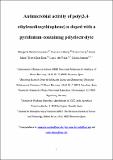Por favor, use este identificador para citar o enlazar a este item:
http://hdl.handle.net/10261/197466COMPARTIR / EXPORTAR:
 SHARE SHARE
 CORE
BASE CORE
BASE
|
|
| Visualizar otros formatos: MARC | Dublin Core | RDF | ORE | MODS | METS | DIDL | DATACITE | |

| Título: | Antimicrobial activity of poly(3,4-ethylenedioxythiophene) n-doped with a pyridinium-containing polyelectrolyte |
Autor: | Sánchez-Jiménez, Margarita; Estrany, Francesc; Borràs, Nuria; Maiti, Binoy; Díaz Díaz, David CSIC ORCID ; Del Valle, Luis J.; Alemán, Carlos | Palabras clave: | Activity Polymers Antimicrobial |
Fecha de publicación: | 30-ago-2019 | Editor: | Royal Society of Chemistry (UK) | Citación: | Soft Matter 15: 7695-7703 (2019) | Resumen: | In spite of p-doped conducting polymers having been widely studied in the last decades and many applications having been developed, studies based on n-doped conducting polymers are extremely scarce. This fact is even more evident when it comes to conducting polymers n-doped with polycations, even though polyanions, such as poly(styrenesulfonate), are often used to obtain p-doped conducting polymers. In this work poly(pyridinium-1,4-diyliminocarbonyl-1,4-phenylene-methylene chloride), abbreviated as P(Py-1,4-P), has been used to prepare n-doped poly(3,4-ethylenedioxythiophene) (PEDOT) electrodes by applying a reduction potential to a de-doped PEDOT film in a P(Py-1,4-P) water solution. The utilization of this cationic polyelectrolyte as an n-dopant agent results in drastic superficial changes, as is observed by comparing the morphology, topography and wettability of p-doped, de-doped and n-doped PEDOT. Cytotoxicity, cell adhesion and cell proliferation assays, which have been conducted using epithelial and fibroblast cell lines, show that the amount of P(Py-1,4-P) in the re-doped PEDOT films is below that required to observe a cytotoxic harmful response and that n-doped PEDOT:P(Py-1,4-P) films are biocompatible. The non-specific bacteriostatic properties of n-doped PEDOT:P(Py-1,4-P) films have been demonstrated against E. coli and S. aureus bacteria (Gram-negative and Gram-positive, respectively) using bacterial growth curves and adhesion assays. Although the bacteriostatic effect is in part due to the conducting polymer, as is proved by results for p-doped and de-doped PEDOT, the incorporation of P(Py-1,4-P) through the re-doping process greatly enhances this antimicrobial behaviour. Thus, only a small concentration of this cationic polyelectrolyte (∼0.1 mM) is needed to inhibit bacterial growth. | Versión del editor: | https://doi.org/10.1039/C9SM01491H | URI: | http://hdl.handle.net/10261/197466 | DOI: | 10.1039/c9sm01491h | Identificadores: | doi: 10.1039/c9sm01491h e-issn: 1744-6848 issn: 1744-683X |
| Aparece en las colecciones: | (IPNA) Artículos |
Ficheros en este ítem:
| Fichero | Descripción | Tamaño | Formato | |
|---|---|---|---|---|
| Antimicrobial_Activity_DDiaz_Soft Matter19.pdf | 4,38 MB | Adobe PDF |  Visualizar/Abrir |
CORE Recommender
SCOPUSTM
Citations
13
checked on 21-abr-2024
WEB OF SCIENCETM
Citations
11
checked on 25-feb-2024
Page view(s)
228
checked on 22-abr-2024
Download(s)
150
checked on 22-abr-2024
Google ScholarTM
Check
Altmetric
Altmetric
Este item está licenciado bajo una Licencia Creative Commons

